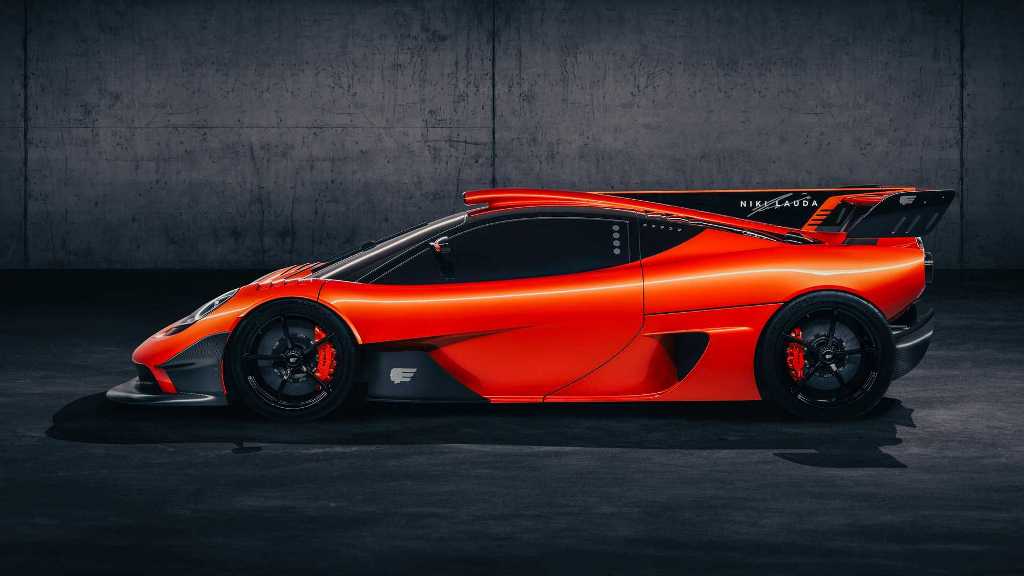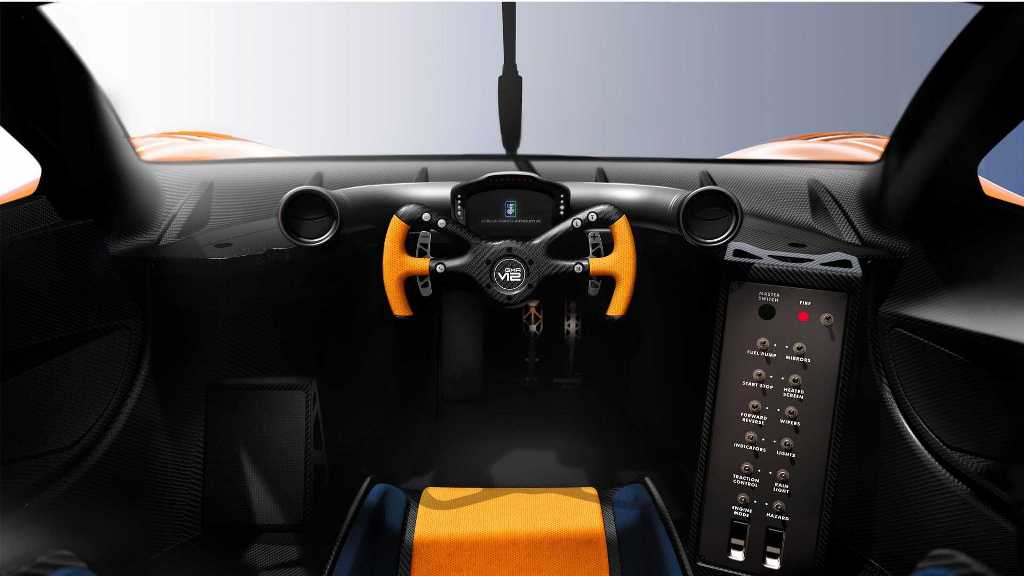Gordon Murray Automotive has unveiled its T.50s Niki Lauda track-focused supercar for the first time. Developed in parallel with the T.50, the most driver-centric supercar ever built, the T.50s Niki Lauda has been conceived, designed and engineered to offer the ultimate on-track driving experience.
Like the T.50, the T.50s Niki Lauda has been designed and engineered without compromise, but with an even more extreme specification. It weighs just 852kg and will be powered by a substantially redesigned version of the T.50's Cosworth-engineered 3.9-litre V12, producing 725bhp, revving to 12,100rpm and going through a newly-designed Xtrac six-speed paddle-shift gearbox. Advanced aerodynamics, aided by a 400mm rear-mounted fan, will produce up to 1500kg of downforce for optimum track performance.
Just 25 T.50s Niki Laudas will be made, costing £3.1m (before taxes). Production will start in January 2023 at Gordon Murray Automotive's manufacturing centre in Dunsfold, Surrey, UK, after the run of 100 T.50 supercars is completed.
Design
Gordon Murray and the team have worked hard on the T.50s body design to achieve their aerodynamic performance targets, whilst retaining the T.50's balanced and classic proportions.
The dramatic aerodynamic features of the T.50s Niki Lauda instantly give away its performance potential. A striking central fin designed to enhance stability features a Niki Lauda logo. At the rear, the distinctive 400mm fan from the T.50 is retained, accompanied by an even larger rear diffuser and a new delta wing. The rear grille features a T.50s badge and 'Fan Car' script.
The aerodynamic elements continue at the front of the car. Barge boards are sculpted to improve airflow to the side ducts, which house the oil cooling systems for the engine and transmission. A splitter and dive planes are also prominent and further reflect the car's aero-influenced design. At the same time, the purity of the T.50 is not lost, creating a purposeful yet elegant look.
Owners will be able to individualise their T.50s Niki Lauda through their choice of colours and liveries, so that no two cars will be alike.
Professor Gordon Murray CBE: "The styling of the T.50s is completely aero driven, but still attractive. There's not one body panel carried over from the T.50, but the road car has such a strong and classic shape that it still manages to shine through."
Engine and transmission
The Cosworth-designed 3.9-litre V12 engine is a dramatically different version of the engine that powers the T.50. It is even more powerful and faster-revving too, delivering 711PS at 11,500rpm, on its way to a 12,100rpm rev-limit. At 178hp/litre, the specific power output of the T.50s Niki Lauda's V12 exceeds that of the all-conquering Cosworth DFV Formula One engine. The power-to-weight ratio of 835PS/tonne betters that of a naturally aspirated LMP1 car.
The T.50s Niki Lauda's engine is fed by a newly-designed, roof-mounted, high-performance RAM induction airbox (which can increase maximum power to 725bhp). The maximum torque figure is 485Nm, produced at 9,000rpm. A newly-developed, bespoke, straight-through exhaust system also takes the engine sound to a new level. Right through the rev-range it promises to be one of the greatest and most characterful sounding cars ever made.
The state-of-the-art V12 pushes the boundaries of engine design even further, with many new components. Changes include completely revised cylinder heads and camshafts, plus a higher compression ratio of 15:1.
Through meticulous attention to detail, this new iteration of the Cosworth GMA V12 weighs just 162kg, 16kg less than what was already the lightest road-going V12 engine ever. The weight-saving measures extend to the intake, exhaust and control systems, as well as the engine itself. All the valves are made from titanium, while there is no variable valve timing due to the additional weight of the geartrain and electronic control system.
Chassis, body and suspension
The T.50s Niki Lauda is built around a specially developed, lightweight carbon fibre monocoque. Optimised for weight reduction and structural rigidity, it is constructed using advanced part-binding technology, with carbon fibre wrapped around a honeycomb aluminium core.
This stiffness and strength also contributes to the T.50s's exceptional occupant safety, with precisely engineered deformable areas. Passengers are further protected by an F1-style 'passenger safety cell'.
Exterior body panels, all unique to the T.50s, are also made from ultra-lightweight carbon fibre. Windows and screens use glazing that has been further reduced in weight from the road car specification.
For exceptional levels of confidence inspiring on-track dynamics, the T.50s Niki Lauda utilises the same forged aluminium front and rear double wishbone suspension system as the T.50. However, the springs, dampers and anti-roll bar have been respecified to optimise track performance, while the ride height has been lowered to 87mm at the front and 116mm at the rear.
Steering
The T.50s Niki Lauda retains the T.50's rack and pinion steering, but with a revised steering ratio.
Brakes
The Brembo carbon ceramic discs of the T.50 are carried over to the T.50s Niki Lauda (370mm x 34mm front/340mm x 34mm rear), with six-piston front callipers and four-piston rear callipers. The braking system and aerodynamics combine to produce incredible deceleration of 3.5g. To ensure the brakes maintain their phenomenal performance throughout a track session, new ducting around each wheel is designed to improve brake cooling.
Wheels and tyres
The T.50s sits on unique and exceptionally light magnesium forged 18-inch wheels, weighing less than 6kg each, with Formula One-style lightweight wheel hubs and a centre lock attachment. The wheels are wrapped in Michelin slick tyres, measuring 250mm wide at the front (25/64 18") and 300mm wide at the rear (30/68 18"). A wet option is also provided.
Aerodynamics
The T.50s Niki Lauda has completely new aero, which combines to create 1500kg of downforce. This includes a new 1,758mm-wide, rear-mounted delta wing, the design of which was inspired by the front wing on Murray's 1983 Brabham BT52 Formula One car and is just as effective today as it was then.
The front of the T.50s features a splitter with a central aerofoil section, which generates huge load figures to balance out those from the rear wing. The splitter's central channel reduces the car's sensitivity to pitch while allowing airflow under the car to continue to drive the central diffuser section, keeping the efficiency of the entire aero package high.







![2026 Kia Sportage [EU] Review: A Refined European Crossover with Bold Style and Electrified Options](https://blogger.googleusercontent.com/img/b/R29vZ2xl/AVvXsEgqMRwJE1m90uCMgRSB6oc4bAzmAaKXJlNoCwavK5fXHaphLYY1sUVXdxUC94zuj95CdjDG2SqRnUBYMqta-dapTLIaHhzEdJAS821ldVMQOKfAZNpQlZ5fYTwKzKbKj8ad9QeKlaQPcNLRZ6zaGvuXhsg1kQ6zQCQqYtjmOM8q9u-a7Nl3WYjp773OLXJR/w680/2026%20Kia%20Sportage%20%5BEU%5D_01.jpg)











0 Comments